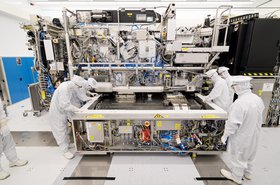The Chinese government has issued a Three Year Plan for new data centers, demanding that new facilities become more efficient, have a PUE of 1.3, and have a utilization of 60 percent by the end of 2023.
The Three-year Action Plan for the Development of New Data Centers (2021-2023) also limits the growth of data centers to 20 percent, and sets out a national architecture supporting national cloud hubs, provincial data centers, and Edge data centers.
Tiers of joy
China has had national plans which set targets for data centers for some years, setting targets in 2015 and calling for a reduction in PUE as long ago as 2012, but the country has been criticized by Greenpeace, which has warned that the country's tech giants are not adopting renewable energy, and the country's digital energy bill is set to quadruple by 2035. The plan proposes incremental changes to combat this.
"In three years, a new data center development pattern with reasonable layout, advanced technology, green and low-carbon, and the scale of computing power compatible with the growth of the digital economy will basically be formed," according to the Ministry of Industry and Information Technology (MIIT) Communication (2021) No. 76 (Google translation).
The Plan is designed to "support digital transformation, as well as to "implement the spirit of the National Communist Party of China" and will "grasp the new development stage, implement the new development concept, and build a new development pattern, with the goal of empowering the development of the digital economy, promote the optimization of the construction of new data centers, the improvement of network quality, the acceleration of computing power, the solidity of the industrial chain, the green and low-carbon development, and the improvement of security guarantees, and create a new intelligent computing power ecosystem.
To that end, the plan calls for an optimized layout in which there is a national hub node of the "national integrated computing power network," with provincial data centers, and Edge data centers laid out in tiers.
As well as improving efficiency, the MIIT plan also wants to increase utilization, so there is less wasted space and power in data centers, calling for a national average utilization rate of 55 percent by the end of 2021, rising to more than 60 percent by the end of 2023. Power usage effectiveness (PUE) meanwhile, will go down from below 1.35 this year to under 1.3 in 2023.
"In severe cold and cold areas, we will strive to reduce it to below 1.25," says MIIT.
This will require new data centers to "take a green development path that is efficient, clean, intensive, and circular," says MIIT, calling for techniques such as high-density integration, refrigeration systems such as liquid cooling, power supply and distribution systems such as high-voltage direct current, and other technologies such as lithium batteries, hydrogen storage, and flywheel energy storage.
During this time, total compute will grow very rapidly, at around 30 percent per year, from 120 exaflops this year to 200 exaflops in 2023, but the MIIT plan calls for densities to increase, so the number of racks grows at about 20 percent per year.
The MIIT wants 10 percent of China's compute in 2023 to be high performance computing (HPC), and 70 percent of the total to be concentrated in hub nodes. IT also calls for an end-to-end delay in the national hub node to be less than 20 milliseconds, one way.
National architecture
The plan calls for national hub notes with data center clusters with large scale computing deployment at Beijing-Tianjin-Hebei, Yangtze River Delta, Guangdong-Hong Kong-Macao Greater Bay Area, and Chengdu-Chongqing.
Other national hubs at Guizhou, Inner Mongolia, Gansu, and Ningxia will concentrate on improving service quality and utilization efficiency of computing power, to work towards a "non-real-time computing power guarantee base for the whole country."
Provinces will get data centers "as needed," which will integrate and improve existing data centers to meet regional business needs.
Edge computing will be deployed flexibly, and the plan wants a power supply system in cities that can support "the calculation, storage, and forwarding of Edge data to meet the needs of new business applications with extremely low latency." To this end, deployment of urban infrastructure such as substations, base stations, and communication rooms should be coordinated.
Old, scattered, and inefficient data centers must be upgraded. with small ones migrated and consolidated to increase energy efficiency.
It also wants reliability: "For data centers that carry important information systems and affect the national economy, people’s livelihood and social order.. enhance the protection capabilities of fire protection, lightning protection, flood protection, and earthquake resistance, strengthen the availability of power supply, cooling and other infrastructure systems, and improve new data centers "




